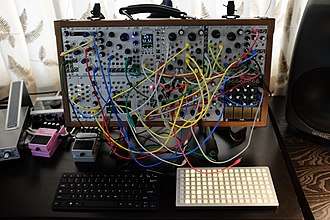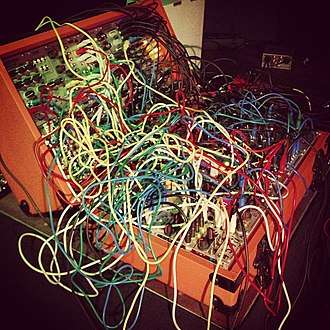Eurorack
Eurorack is a modular synthesizer format originally specified in 1996 by Doepfer Musikelektronik.[1][2][3] It has since grown in popularity, and as of 2018 has become a dominant hardware modular synthesizer format, with over 5000 modules available from more than 270 different manufacturers ranging from DIY kits and boutique, cottage-industry designers to well-known, established synth mass-manufacturers like Moog and Roland.[4][5]

Compact size, 3.5mm mono jacks and cables for patching all signals, and lack of a visual or sonic aesthetic defined by one manufacturer sets Eurorack apart from other modular synthesizer formats, and these factors have contributed to the popularity of Eurorack among both manufacturers and musicians.[6][7]
History

Before Eurorack, in the late 1970s, several modular systems based on the industrial “Euro” card frames appeared:
- Elektor Formant (3u or 6u x 7HP, 3.5mm jacks, 31 pin bus, +/-15v)
- BME PM10/Axiom (3u x 8HP, phono/rca jacks, 31 pin bus, +/-15v)
- The Synton 3000 (3u x 8HP, 4mm “banana” jacks, +/-15v) was of similar format, but constructed more like a modern Eurorack synth.
By the late 1980s, these had all ceased production.
Dieter Döpfer built some Formant modules before producing his own systems. His Voice Modular System from the early 1980s was a Eurocard-based "modular" (the modules were non-patchable voice cards etc.) polyphonic synth, but the front panels look very similar to the later A100 modules.
In 1996, Doepfer Musikelektronik released the first Eurorack-format modular synthesizer system, the Doepfer A-100, followed by successive new series of compatible modules in 1997 and 1998.[2] In the UK, Analogue Systems had been independently developing a very similar format, with small technical differences such as the power connectors. Analogue Systems would later change their products to offer Eurorack compatibility.[8]
In the mid 2000s, other manufacturers such as Cwejman, Make Noise Music and TipTop Audio adopted Doepfer's Eurorack format and started designing and manufacturing compatible modules.[9][10][11]
By 2013, the Eurorack format had gained in popularity. Music technology journalists estimated that there were already at least 80 manufacturers offering over 700 modules, greatly expanding the musical possibilities available from a Eurorack system to include sampling and sample manipulation, West-coast-style wavefolding, DSP-based effects and more.[12]
In the mid 2010s, increasing interest in Eurorack modulars prompted large, well-known music technology manufacturers to start producing Eurorack-compatible equipment aimed at this new market. In addition to modules, manufacturers like Arturia started producing outboard devices such as the Beatstep and Microbrute[13] designed to be able to communicate with Eurorack modular synthesizers via 3.5mm jacks transmitting control voltages.[14] In 2015 Moog released the Mother 32, a Eurorack-compatible semi-modular synthesizer.[15]
By the end of fall 2018, the ModularGrid website included more than 316 manufacturers[16].
Specifications

For synthesizers, Eurorack is a de facto standard to allow different modules to fit in the same cases and communicate among themselves. The basic requirement is compatibility with the Doepfer technical specifications:
Physical
The physical specification is based on the Eurocard standard of:
- 3U (133.4mm), where height "U" is measured in rack units, rounded for a lip.
- 1HP (5.08mm), where width "HP" is measured in horizontal pitch units, rounded down. A card width is integer multiples of 1HP.
Eurorack modules may be further characterized by depth: shallow modules (2.5cm to 4cm) can fit into "skiff" cases.
Electrical
Eurorack defines a common power supply and power connector: a 10- or 16-pin ribbon cable supplying a dual rail 12v DC power supply. Power connectors can also include a 5V DC power supply, and CV and Gate buses.
Audio and control signals are exchanged between modules via 3.5mm mono jack cables. The electrical characteristics of signals are split into three loosely defined categories:
- Audio signals are typically a maximum of 10V peak-to-peak (i.e. between -5V and +5V)
- Control voltages can either be unipolar or bipolar. Bipolar control voltages are typically 5V peak-to-peak (i.e. from -2.5V to +2.5V), unipolar voltages between 0V and 8V. The V/Octave scale is used for pitch information
- Trigger, Gate or Clock signals are digital 0V to 5V pulses typically used for timing and event signalling.
1U Modules

Several manufacturers offer Eurorack-compatible modules in a smaller 1U tall format, sometimes referred to as "tiles". As of 2018 there are two competing standards for 1U modules, differing mainly in their height. 1U modules manufactured by Intellijel are 39.65mm high,[19] whereas 1U modules manufactured by Pulp Logic and other manufacturers are 43.2mm high.[20] Pulp Logic also proposes a more compact power connector for 1U modules, consisting of only three pins.
DIY and open source
_-_view2.jpg)
The technical and modular nature of Eurorack often attracts people who are interested in modifying or building their own modules or cases. Many Eurorack manufacturers started off as individuals building "do it yourself" (DIY) modules or offering DIY kits before expanding into production. Building DIY modules can be a gateway to learning more about electronics and physical manufacturing, as well as being satisfying and developing a more intimate connection with the synthesizer as a personal musical instrument.
Some manufacturers such as Befaco, Bastl Instruments and Erica Synths offer some or all of their modules both as assembled products or as kits to be assembled by the buyer.[21][22] Doepfer offers a case and power supply kit, as well as 'low cost' cases designed to be customised and finished by the buyer.
Releasing modules exclusively as open source designs and DIY kits allows designers such as Music Thing Modular to design and release popular modules such as the Turing Machine or Radio Music without having to run a company or invest in manufacturing. Open Source licenses for both hardware and code allow individuals to build the modules from scratch, and companies such as Thonk to offer kits.[23][24]
Some manufacturers do not offer kits or intend for end users to build their products, but release the code, schematics and layout under open source licenses. Émilie Gillet of Mutable Instruments cites transparency and the possibility for customers to customise or modify their modules as driving reasons for this decision.[25]
Notable users

- Alessandro Cortini
- Beirut
- Blush Response
- Coldplay[26]
- Daedelus (musician)
- Deadmau5
- Depeche Mode
- Emily A. Sprague (Florist)[27]
- Erika M. Anderson (EMA)[28]
- Rayna Russom (LCD Soundsystem)
- Geologist (Animal Collective)[29]
- JunkieXL[30]
- Kaitlyn Aurelia Smith[31]
- Keith Fullerton Whitman
- Kyteman
- Lady Starlight
- Luke Abbott
- Nine Inch Nails[32]
- Orphx[33]
- Richard Devine
- Robert Aiki Aubrey Lowe
- Surgeon[34]
- The Blow
- Venetian Snares[35]
See also
References
- Groves, Wesley. "Intro to Eurorack Part I: Doepfer's Beginnings and Power Supply Basics". Reverb. Retrieved 24 March 2018.
- Doepfer, Dieter. "Zeit-Tabelle". Doepfer Musikelektronik. Retrieved 24 March 2018.
- "Dieter Doepfer: Completing the Circuit". Ableton Blog. Ableton. 18 February 2015. Retrieved 24 March 2018.
- "Modulargrid". Modulargrid. Retrieved 24 March 2018.
- Scarth, Greg (2013-03-29). "Dreaming of Wires: The Return of Modular Synths". Attack. Retrieved 24 March 2018.
- Ferguson, Tom (2 September 2015). "Interview with Olivier Gillet (Mutable Instruments)". Keith McMillan Instruments. Retrieved 1 April 2018.
- Wilson, Scott (21 September 2017). "Are modular synths worth the hype? Four artists share their Eurorack secrets". Factmag. Retrieved 1 April 2018.
- Reid, Gordon (November 2012). "Bob Williams: The Analogue Systems Story". Sound on Sound. Retrieved 24 March 2018.
- Reid, Gordon. "Cwejman VM1". Sound on Sound. Retrieved 24 March 2018.
- "About Make Noise Music". Make Noise Music. Retrieved 24 March 2018.
- Mishra, Jyoti (April 2009). "The SOS Guide To Choosing A Modular Synth". Sound on Sound. Retrieved 24 March 2018.
- James, Al (April 2013). "The Secret World Of Modular Synthesizers". Sound on Sound. Retrieved 24 March 2018.
- Preve, Francis (15 January 2014). "Arturia Microbrute Reviewed". Keyboard Magazine. Retrieved 24 March 2018.
- Kirn, Peter (17 January 2018). "Arturia's new easy, affordable modular cases also mount to MiniBrute 2". Create Digital Music. Retrieved 24 March 2018.
- Reid, Gordon (January 2016). "Moog Mother–32". Sound on Sound. Retrieved 24 March 2018.
- "Manufacturers". ModularGrid.
- "Construction Details A-100". Doepfer Musikelektronik. Retrieved 8 April 2019.
- "Technical Details A-100". Doepfer Musikelektronik. Retrieved 24 March 2018.
- "Technical Specifications". Intellijel. Retrieved 24 March 2018.
- "1U Tiles". Pulp Logic. Retrieved 24 March 2018.
- Johannes (3 September 2015). "Bastl Instruments DIY Modular – Eurorack im Selbstbau". Gearnews (in German). Retrieved 1 April 2018.
- Arblaster, Simon (7 December 2016). "Bastl Instruments ends the year with three new DIY offerings". Musicradar. Retrieved 1 April 2018.
- "Getting Started Making DIY Eurorack Modules". Synthtopia. 18 Feb 2016. Retrieved 1 April 2018.
- Whitwell, Tom (8 Feb 2012). "Music Thing: A Radio Sequencer, How to Get Into DIY Synth Modules, How to Have Fun". CDM. Retrieved 1 April 2018.
- Callum, Fynn (22 July 2015). "Mutable Instruments – Olivier Gillet interview". Red Dog Music. Retrieved 1 April 2018.
- "Even Coldplay have a modular synth". FACT. 17 May 2015. Retrieved 24 March 2018.
- Bennett, Katie (18 January 2016). "You Can Make Anything Into Music: An Interview With Emily Sprague". Rookie. Retrieved 3 April 2018.
- Ludwig, Jamie (2017-11-09). "Gear Guide: For EMA, Guitar is Just the Beginning…". She Shreds. Retrieved 1 April 2018.
- Weingarten, Christopher (2015-11-30). "Animal Collective Talk Escaping Reverb on 'Minimal' 10th Album 'Painting With'". Rolling Stone. Retrieved 18 September 2018.
- Holkenborg, Tom (2016-03-08). "Synths of Deadpool - Studio Time with Junkie XL". Youtube. Retrieved 2020-01-29.
- Avery, Myles (7 September 2016). "8 Artists Making Brilliant Exploratory Music Using Modular Synths". Soundfly. Retrieved 24 March 2018.
- Reyes, Jordan (7 March 2017). "A Look at 5 Musicians and Their Massive Modular Rigs". Reverb. Retrieved 24 March 2018.
- Darst, Nihan (25 August 2017). "The Magic Of Modular Synths (And Why Artists Love Them)". MPC. Retrieved 24 March 2018.
- Kirn, Peter (8 July 2015). "Techno Legend Surgeon Breaks Down His Live Modular Set". CDM. Retrieved 1 April 2018.
- "In pictures: Venetian Snares' modular-stuffed studio". musicradar. 1 March 2016. Retrieved 1 April 2018.
External links
| Wikimedia Commons has media related to Eurorack. |
- Eurorack on Synth DIY wiki
- Eurorack Rails DIY Guide
- ModularGrid — an interactive database of modules and manufacturers